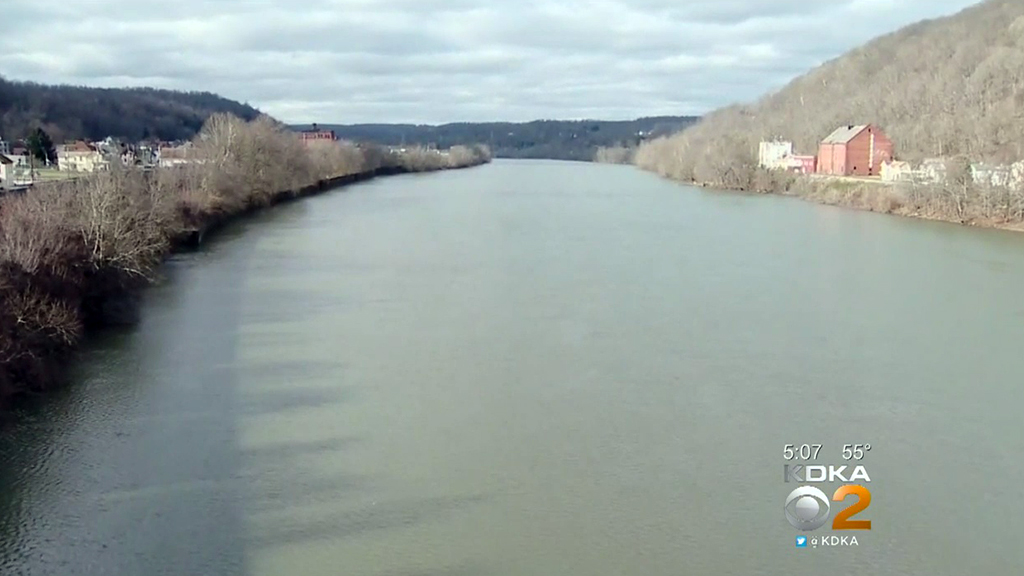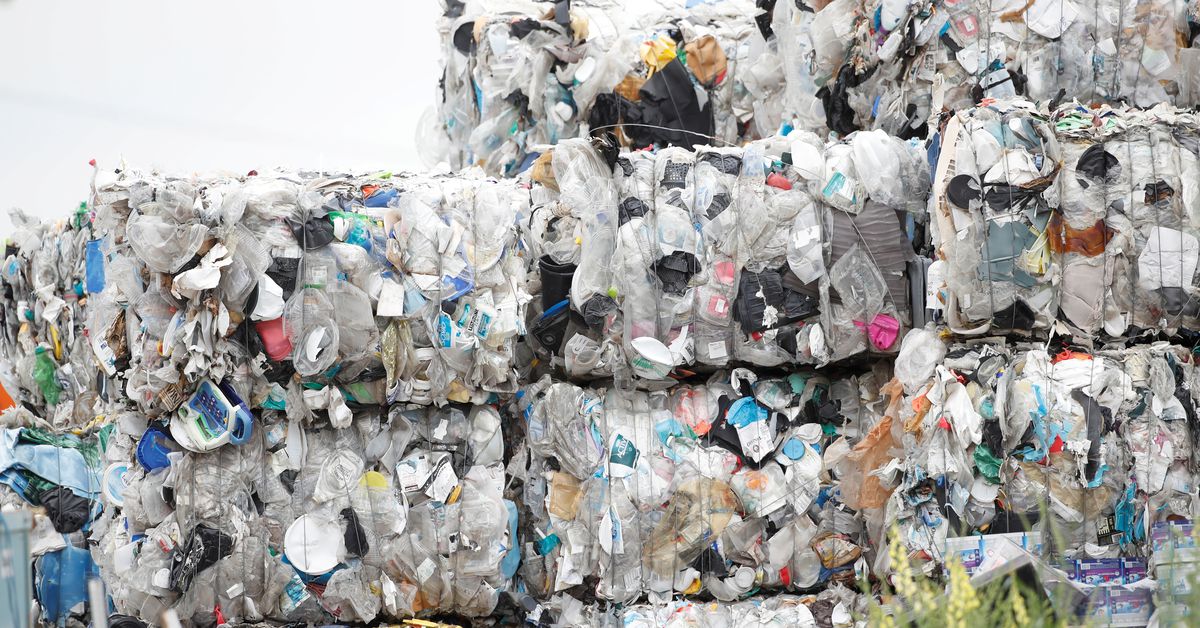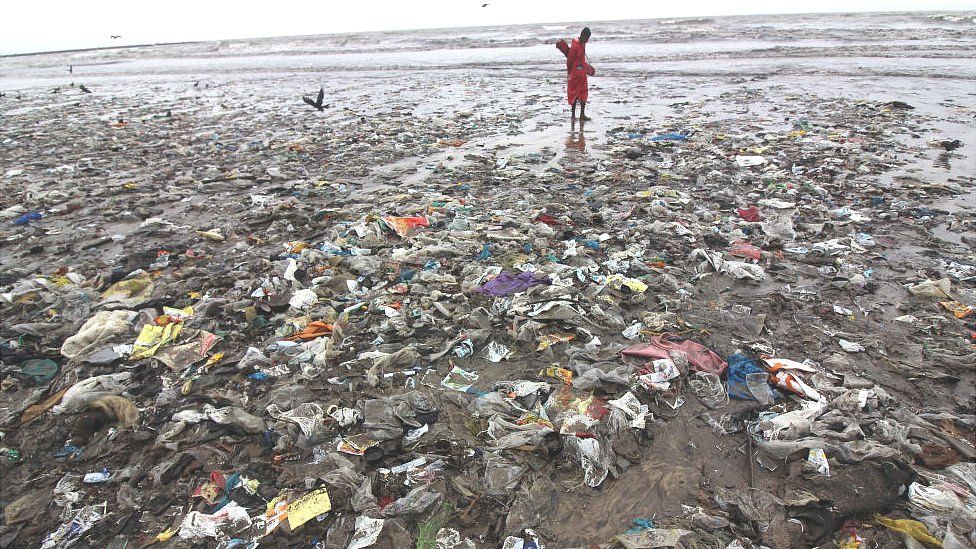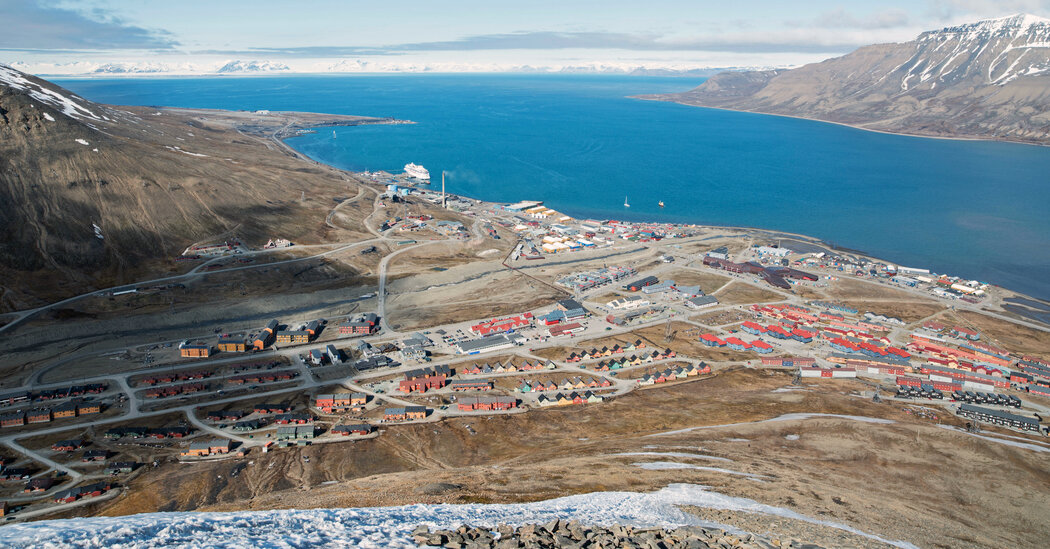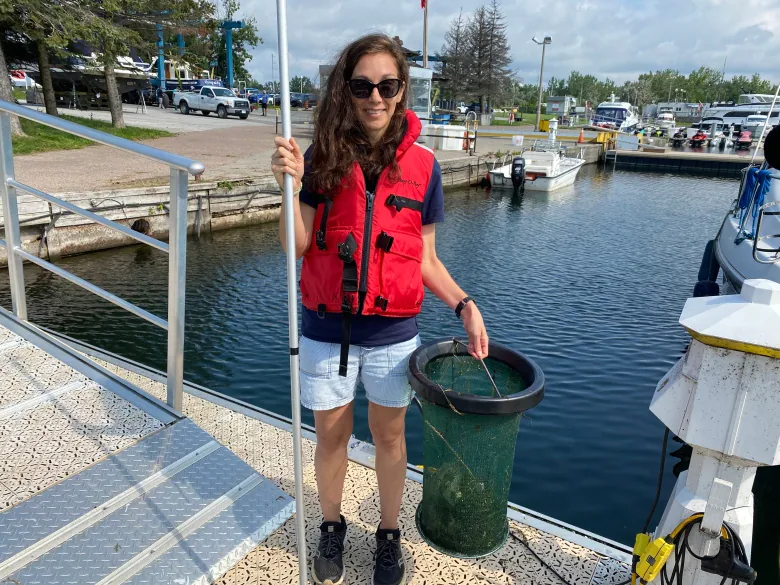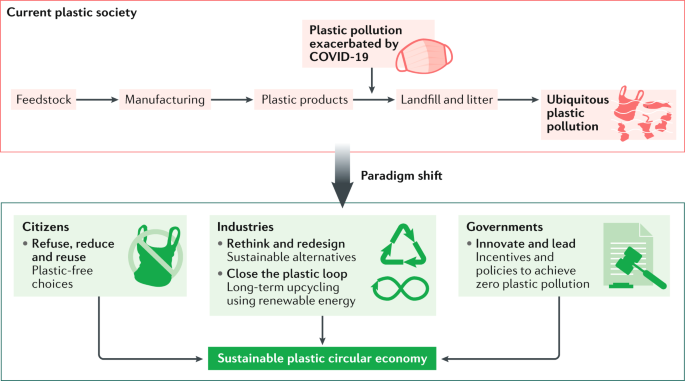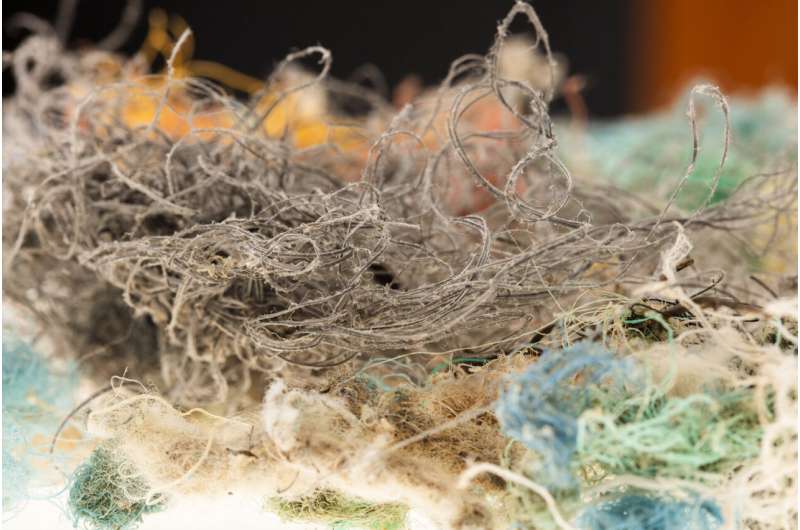PITTSBURGH (KDKA) — Plastic bags are everywhere, including our homes and stores.The deputy director of PennEnvironment said they are also in our water and on our streets. The organization tested 53 popular waterways in the state, including Pittsburgh’s three rivers, and found the waterways are contaminated with microplastics, which are pieces of plastic smaller than a grain of rice.READ MORE: 4 Men Facing Charges Connected To “Grandparent Bond Scams” In Allegheny And Westmoreland Counties“Often, these tiny pieces of plastic contain chemicals linked to cancer and hormone disruption,” said deputy director Ashleigh Deemer. “They can be in our drinking water sources and they can be taken up by fish and later consumed by us.”Deemer said people consume about a credit card’s worth of plastic each week. She added that plastic bags also cause a litter problem and negatively impact climate change.“Without changing course, we know that emissions from plastic production and incineration could amount to 56 gigatons of carbon between now and 2050,” Deemer said. “That’s almost 50 times the annual emissions of all the coal-fired power plants in the U.S.”Deemer said one of the best ways to save people and the planet is to ban plastic bags. More than 100 organizations and business owners signed a letter to show their support.The owner of City Books is one of the supporters.READ MORE: Fall Fun: 2021 Guide To Festivals, Farms And Haunts In Western Pa.“I think that paper bags keep our business model itself sustainable, and then we’re able to pay that forward in terms of the environment and our customers,” owner Arlan Hess said.Deemer said they’re urging Pittsburgh City Council members to ban plastic bags.“We estimate this policy has the potential to prevent 108 million plastic bags from entering our waste stream and environment each year,” Deemer said.Local residents KDKA spoke to support the idea.“I’ll use a plastic bag for kitty litter, but I can also use a paper bag for that as well,” Shadyside resident Franc Grigore said.MORE NEWS: With Expanded And New Programs, Democrats Say Human Infrastructure Bill Will Rebuild American Middle ClassCouncilmember Erika Strassburger said she has been working on legislation to ban plastic bags for months. She plans to introduce a bill this fall.
Author Archives: David Evans
Democrats weigh first nationwide fee on plastic in U.S. budget negotiations
Bales of hard-to-recycle plastic waste are seen piled up at Renewlogy Technologies in Salt Lake City, Utah, U.S., on May 17, 2021. REUTERS/George FreyWASHINGTON, Sept 29 (Reuters) – U.S. congressional Democrats are considering including the first federal fee to tackle plastic pollution in the multitrillion-dollar reconciliation bill, a proposal that is drawing opposition from the plastics and petrochemical industry.Senator Sheldon Whitehouse and Representative Tom Suozzi are in talks with other Democrats to include their REDUCE Act as a source of revenue in the reconciliation bill. It would impose a 20-cent-per-pound fee on virgin – or new – plastic for single-use products such as plastic bags and beverage containers.The proposal is among a slew of money raisers being considered by the White House and Democrats to pay for a package that includes provisions aimed at tackling climate change and expanding the public safety net. The measure, which Democrats aim to pass without Republican support, is a pillar of President Joe Biden’s domestic agenda.White House officials declined to comment. But two sources familiar with the Biden administration’s thinking said it is reluctant to back the plastics fee because it could drive up costs for consumers.More than 90% of plastic produced gets dumped or incinerated because there is no cheap way to repurpose it, according to a 2017 study by researchers from UC Santa Barbara, the University of Georgia and Woods Hole published in the journal Science Advances.The REDUCE Act would compel plastic producers to use more recycled content and direct revenue toward a fund to support recycling and address plastic marine debris and other pollution.”That pollution chokes our oceans, hastens climate change, and threatens Americans’ well-being, and it’s the plastics industry that should cover the cost of the damage,” Whitehouse said.The American Chemistry Council (ACC), which represents some of the largest plastics and petrochemical companies, launched an ad campaign this month opposing the prospective fee, saying the measure would raise the cost of consumer goods.ACC spokesman Matthew Kastner said the group has also been lobbying lawmakers to reject the idea and is “beginning to engage the White House.”Reporting by Valerie Volcovici and Jarrett Renshaw; Editing by Peter CooneyOur Standards: The Thomson Reuters Trust Principles.
You do know that, in most cases, bottled water is just tap water?
Since the start of the pandemic, thirsty Americans have drowned their sorrow in bottled water.Even before the coronavirus blew into all our lives, bottled water was, and has been for years, the No. 1 beverage in the United States, surpassing soft drinks as the choice of increasingly health-conscious consumers.The COVID-19 pandemic only accelerated things.According to a recent report from the International Bottled Water Assn., sales of bottled water exploded last year “as consumers stocked up in order to stay home amid the coronavirus crisis.”
“Per-capita consumption of bottled water reached another all-time high,” it said.Gary Hemphill, managing director of research for the consulting firm Beverage Marketing Corp., told me bottled water sales are projected to be even higher this year.“Bottled water’s success is driven by its healthful image and positioning as a beverage to be consumed virtually any time and anywhere,” he said.Call this a triumph of perception over reality.
Business
Column: If you’re a coffee drinker, you really need to care about climate change
Coffee prices, and food costs in general, are rising because of climate change. For consumers, that’s a good reason to take this problem seriously.
The first thing you need to know is that, for most Americans, there’s absolutely nothing wrong with your tap water.The second thing you should know is that the market leaders for bottled water — Coke and Pepsi — are just filtering and bottling tap water, and then selling it at a big markup.And perhaps most important of all, bottled water is no friend to the environment.
According to the Container Recycling Institute, Americans throw away more than 60 million plastic water bottles every day. Most end up in landfills, gutters and waterways.“If your tap water is potable, which is the case for most big cities in America, you don’t need bottled water,” said Barry Popkin, a professor of nutrition at the University of North Carolina at Chapel Hill.“There’s an aura of greater safety around bottled water,” he told me. “That’s just not valid.”I heard the same from the Metropolitan Water District of Southern California, which serves municipalities and water districts throughout the region.
Paul Rochelle, the agency’s water quality manager, said almost a quarter-million tests are performed annually on the local water supply to ensure safety.“Not only is our water safe, it tastes great,” he said. “Metropolitan has three times won best-tasting tap water in the nation, including this past year.”
Business
Ever wonder where your drinking water comes from? A reader asked and we answer
L.A. pumps its local groundwater, but other water sources are important for replenishing the supply.
Global bottled water sales hit nearly $218 billion last year, according to Grand View Research. Sales are expected to rise by 11% a year through 2028.
“Rising consumer consciousness towards the health benefits of consuming bottled water is projected to drive market growth over the forecast period,” the research firm said.Those health benefits, however, are questionable.“To my knowledge, there is no published evidence to suggest that bottled water is either healthier or safer than tap water — none whatsoever,” said Dan Heil, a professor of exercise physiology at Montana State University.“In fact,” he told me, “there is published evidence to suggest exactly the opposite.”
Business
Column: Adding dental coverage to Medicare makes a lot of sense — except to dentists
Democrats are again trying to bring dental coverage to Medicare. Dentists, fearing lower payments, are against the idea.
Heil said that when tap water is filtered for bottling, the process removes beneficial minerals such as calcium and magnesium. The bottled water industry considers these minerals “impurities,” he said.“While stripping the impurities from tap water does, in fact, provide a nearly pure form of water, that fact does not support the premise that pure water is healthier or better for the body than tap water with naturally occurring minerals,” Heil observed.The leading bottled water brands are nothing more than municipal tap water that’s been run through a filter. This is what Coca-Cola does with its Dasani water. Pepsi does the same with its Aquafina brand.
“Bottled water is tap water,” said Marion Nestle, a highly regarded professor emeritus of nutrition, food studies and public health at New York University.“Companies buy water from municipal supplies at very low cost and sell it back to the public at a huge markup,” she told me. “I am not aware of any evidence that bottled water is safer than city water in places where cities take care of their water.”Some cities may not do that so well; Flint, Mich., comes to mind. But, as Popkin noted, most big cities do a good job of maintaining safe drinking water.In 2012, California wrote into the state Constitution that safe drinking water is a human right. Although the tap water in most California cities passes muster, some rural areas still face challenges.
California
A 7.1 earthquake couldn’t kill this Mojave Desert town. But a water war just might
The small desert town of Trona imports its water from 30 miles away. A 2014 law aimed at preserving California’s groundwater has set off a complicated battle that has some residents fearing the worst.
The problem is most acute in the Central Valley, where large farms have contaminated water supplies with agricultural chemicals. The state passed a law in 2019 allocating $130 million a year to improve that situation.If you’re among the vast majority of Californians with access to safe drinking water, all you’re doing any time you purchase bottled water is enriching the conglomerates that, unlike you, simply turned the faucet.“Unfortunately, many people spend their hard-earned money paying for bottled water rather than using their own tap water,” said Walter C. Willett, a professor of epidemiology and nutrition at Harvard University. “This rarely makes sense.”
Yes, bottled water is convenient. But it’s really not that difficult to fill a reusable bottle before you leave home. You’ll save money and, in most cases, won’t cut corners on safety.For extra peace of mind, look into one of the many filtration systems available for home use. Prices start around $20.And let’s hammer this point home: Bottled water is really bad for the environment.A recent study out of Europe found that the impact of bottled water on natural resources, including the millions of barrels of oil needed to manufacture all those plastic bottles, is 3,500 times higher than for tap water.
And seeing as your bottled water probably came from municipal pipes anyway, you’re being played for a chump by the roughly $200-billion U.S. beverage industry.Cheers!
Climate Change: Don't sideline plastic problem, nations urged
Getty ImagesScientists are warning politicians immersed in climate change policy not to forget that the world is also in the midst of a plastic waste crisis. They fear that so much energy is being expended on emissions policy that tackling plastic pollution will be sidelined. A paper from the Zoological Society of London (ZSL) and Bangor University says plastic pollution and climate change are not separate.It says the issues are actually intertwined – and each makes the other worse. Manufacturing plastic items adds to greenhouse gas emissions, while extreme weather such as floods and typhoons associated with a heating planet will disperse and worsen plastic pollution in the sea.The researchers highlight that marine species and ecosystems, such as coral reefs, are taking a double hit from both problems. Hermit crabs mistake plastic pollution for foodPlastic from take-out food is polluting the oceansUK criticised for dumping plastic waste in TurkeyGetty ImagesReefs and other vulnerable habitats are also suffering from the seas heating, from ocean acidification, pollution from farms and industry, dredging, development, tourism and over-fishing. And in addition, sea ice is a major trap for microplastics, which will be released into the ocean as the ice melts due to warming. The researchers want politicians to address all these issues – and not to allow climate change to take all the policy “bandwidth”.Professor Heather Koldewey from ZSL said: “Climate change is undoubtedly one of the most critical global threats of our time. Plastic pollution is also having a global impact; from the top of Mount Everest to the deepest parts of our ocean. “Both are having a detrimental effect on ocean biodiversity; with climate change heating ocean temperatures and bleaching coral reefs, to plastic damaging habitats and causing fatalities among marine species. “The compounding impact of both crises just exacerbates the problem. It’s not a case of debating which issue is most important, it’s recognising that the two crises are interconnected and require joint solutions.” Professor Koldewey added: “The biggest shift will be moving away from wasteful single-use plastic and from a linear to circular economy that reduces the demand for damaging fossil fuels.” Helen Ford, from Bangor University, who led the study, said: “I have seen how even the most remote coral reefs are experiencing widespread coral death through global warming-caused mass bleaching. Plastic pollution is yet another threat to these stressed ecosystems. “Our study shows that changes are already occurring from both plastic pollution and climate change that are affecting marine organisms across marine ecosystems and food webs, from the smallest plankton to the largest whale.” ZSL is urging world governments and policy makers to put nature at the heart of all decision making in order to jointly tackle the combined global threats of climate change and biodiversity loss.Follow Roger on Twitter @rharrabin
This fjord shows even small populations create giant microfiber pollution
Researchers found that one tiny Arctic village’s unfiltered sewage produces as much microplastic as the treated waste of more than a million people.Svalbard, a Norwegian archipelago chilling halfway between the Nordic country and the North Pole, is known as much for its rugged beauty as its remoteness. From the village of Longyearbyen, visitors and roughly 2,400 residents can appreciate the stark terrain around the fjord known as Adventfjorden.But the beauty of this Arctic inlet conceals messier, microscopic secrets.“People see this nice, clean, white landscape,” said Claudia Halsband, a marine ecologist in Tromso, Norway, “but that’s only part of the story.”The fjord has a sizable problem with subtle trash — namely microfibers, a squiggly subset of microplastics that slough off synthetic fabrics. Microfibers are turning up everywhere, and among researchers, there’s growing recognition that sewage is helping to spread them, said Peter S. Ross, an ocean pollution scientist who has studied the plastic fouling the Arctic. While the precise impact of microfibers building up in ecosystems remains a topic of debate, tiny Longyearbyen expels an extraordinary amount of them in its sewage: A new study shows that the village of thousands emits roughly as many as all the microplastics emitted by a wastewater treatment plant near Vancouver that serves around 1.3 million people.The findings, published this summer in the journal Frontiers in Environmental Science, highlight the hidden impacts that Arctic communities can have on surrounding waters, as well as the major microfiber emissions that can be produced by even small populations through untreated sewage.Adventfjorden’s microfibers arrive through a submerged pipe that juts into the fjord like an arm bent at the elbow. It spits out the community’s untreated sewage — urine and feces, plus mush pushed down kitchen sinks and suds from showers and washing machines. Around the world, small or isolated communities wrangle sewage in numerous ways, from corralling it in septic tanks to relying on composting latrines. In Longyearbyen, waste mingles in a single pumping station no bigger than an outhouse before squelching to the fjord through tubes winding atop the frozen earth.“People think, Out of sight, out of mind; the ocean will take care of it, but this stuff piles up,” Dr. Halsband said.Microscopes helped researchers make sense of the tiny trash they’d scooped from the pumping station, and estimate how many of the microfibers, shown here, might be spilling into the fjord.Maria JensenCurious about trash that isn’t immediately visible to the naked eye, Dr. Halsband and four collaborators sampled the wastewater for microfibers over one week each in June and September 2017, then modeled how the tiny bits might float around the fjord.“It wasn’t as smelly as we were afraid it would be, but there were floaters,” said Dorte Herzke, a chemist at the Norwegian Institute for Air Research and the lead author of the paper.Back in the lab, researchers filtered and sorted the samples. Lacking equipment that could identify fibers as synthetic or organic, the team discarded anything clear or white that might be cellulose. Still, scores of pieces remained, including dark colors likely from outdoor gear — especially in the September samples, collected “when the hunters start to emerge” and bundle up, Dr. Herzke said. (Previous research found that outerwear such as synthetic fleece tends to shed microfibers in washing machines.)From these counts, the researchers estimated that the community flushes at least 18 billion microfibers into the fjord each year — roughly 7.5 million per person.To start puzzling out what happens to the bits in Adventfjorden, the team modeled where the microfibers could accumulate and which species might encounter them. The researchers calculated that the lightest microfibers would stay suspended near the surface and leave the fjord within days, dispersing in roomier waters. Heavier ones would sink to the bottom or cluster near the sewage pipe or inner shore, places that are habitats for plankton, bivalves and bloody-red worms.Deonie and Steve Allen, married microplastics researchers at the University of Strathclyde in Scotland and Dalhousie University in Nova Scotia, praised the paper’s model and said in an email that its “really local and timely field data and sampling” bolster its results. But they said it would benefit from chemical analysis, too, a sentiment echoed by Sonja Ehlers, a microplastics researcher at the University of Koblenz-Landau in Germany. Ms. Ehlers said she would also like to see the team document how local creatures are interacting with the microfibers.Dr. Halsband suspects they might be consuming the castoffs. “We know they don’t discriminate against plastic,” she said, adding that the team is also keen to learn whether fibers can snarl planktons’ appendages and interfere with their drifting.Dorte Herzke, documenting walruses with Longyearbyen in background.Louise Kiel JensenThe researchers returned to the fjord this past summer, collecting samples to check the model’s predictions. Those samples are in a freezer, and will be subjected to a chemical analysis.The scientists hope their work will prompt Arctic communities to mull new ways to manage sewage and the trash that hitchhikes through it.“Norway has a lot of fjords,” Dr. Herzke said, and Adventfjorden surely isn’t the only one flecked with feces and tiny pieces of trash. That makes it a useful case study. “Once we understand this one,” Dr. Herzke added, “we can understand others.”Where thorough sewage treatment isn’t feasible, Dr. Halsband said, communities could consider basic filtration, promote wool alternatives to synthetics and eke out more wears between washes.As for Longyearbyen, the researchers said it will soon introduce filtration to capture large debris. That may intercept some smaller bits, too — maybe even downright teeny ones.
Industrial plastic is spilling into Great Lakes, and no one's regulating it, experts warn
As the people of Toronto flocked to the Lake Ontario waterfront to swim, paddle and generally escape pandemic isolation, Chelsea Rochman’s students at the University of Toronto were throwing plastic bottles with GPS trackers into the water.The research team’s goal is to track trash that ends up in the lake, to figure out where it accumulates in the water and where it’s coming from in the first place. Using information from the tracking bottles, they chose spots to put in Seabins — stationary cleaning machines that suck in water all day and trap any garbage and debris — at marinas along the waterfront. They are emptied daily, and the debris collected in them is examined to ferret out what kinds of trash is getting into the lake. Chelsea Rochman, an assistant professor at the University of Toronto, and her team have been analyzing plastic waste being collected by Seabins placed in the Toronto harbour.
The COVID-19 pandemic necessitates a shift to a plastic circular economy
The COVID-19 pandemic is exacerbating plastic pollution. A shift in waste management practices is thus urgently needed to close the plastic loop, requiring governments, researchers and industries working towards intelligent design and sustainable upcycling.
Plastic pollution is ubiquitous. As of 2015, approximately 6,300 million metric tons (Mt) of plastic waste had been generated globally1, motivating myriad initiatives to reduce plastic consumption. However, the focus on plastic waste reduction has since been overshadowed by the COVID-19 pandemic. Traditionally minor sources of plastic pollution — including personal protective equipment (PPE) — have become far more prominent, exacerbating consumption. Moreover, some regulatory measures meant to reduce plastic have been delayed and/or rolled back during the pandemic, stalling or even reversing the longstanding global battle to mitigate plastic pollution.Approximately 400 Mt of plastic waste was produced globally in 2019 (ref.1). However, the estimated waste volume reached over 530 Mt in the first 7 months of the COVID-19 outbreak (December 2019–June 2020) (ref.2), suggesting plastic waste totals for 2020 would be at least double those of 2019. Part of this increase results from the public demand for disposable face masks and gloves; globally, an estimated ~3.4 billion protective face masks were discarded daily from December 2019 to June 2020 (ref.2). Moreover, the consumption of plastic packaging by takeaway services, e-commerce outlets and express delivery industries increased extensively with social distancing requirements. Takeaway and home delivery services generated additional 1.21 Mt of plastic waste from April to May 2020 during the lockdown in Singapore alone.A notable portion of this waste does not make it to municipal waste streams. Masks, gloves and other plastics (including hand sanitizer bottles) are found indiscriminately littered and disposed of without precautionary measures. Such inadequate plastic waste management results in an alarming accumulation of plastic in soil and aquatic ecosystems. For example, it is estimated that approximately 1.56 billion face masks (~5.66 Mt of plastic) ended up in the oceans in 2020. Large pieces of plastic waste, (including masks,) can break into microplastics ( >100 nm and
Plastics industry lashes out at 'regressive' Democratic tax plan
A Democratic proposal to help finance the party’s $3.5 trillion spending bill by taxing single-use plastics is generating sharp pushback from members of the industry, who argue it would produce more waste and hurt average Americans.The Senate Finance Committee is weighing the idea of a tax on the sale of virgin plastic resin — the base materials used to make single-use plastics — as one potential way to pay for the mammoth spending bill, according to a document released earlier this month.But the proposal has garnered fierce opposition from the plastics division of the American Chemistry Council (ACC), a trade group representing 28 companies including oil giants such as ExxonMobil, Chevron and Shell as well as major chemical manufacturers such as DuPont and Dow Chemical.ADVERTISEMENTThe group argues that such a levy would amount to some $40 billion in additional taxes and “punish Americans” who depend on plastics in electric vehicles, home insulation, electronics and packaging, while funding unrelated government programs and fueling inflation.“Plastic goes into a variety of applications, not just food packaging,” Joshua Baca, vice president of the ACC’s plastics division, told The Hill. “At the end of the day, this would result in a regressive tax that would largely impact those who can least afford it.”Baca argued that implementation of the measure would lead to “incentivizing the use of other materials — whether that’s paper, glass, aluminum — all of which have a higher [carbon] footprint than plastics.”Manufacturing such alternatives produces 2.7 times more greenhouse emissions than their plastic counterparts and consumes twice as much energy, Baca contended.If all plastic bottles were replaced by glass ones, the power necessary to manufacture them would be the equivalent to running 22 large coal fired power plants, he said, arguing that such a shift would negatively impact the climate and “also be detrimental to our economy.” A plastic resin tax is not the only funding option under consideration for the $3.5 trillion spending bill. The Senate Finance Committee is also discussing taxes on stock buybacks and on corporations whose CEO pay exceeds the pay of their average workers, as well as energy-tax proposals.ADVERTISEMENTThe idea for a plastics tax was first introduced by Sen. Sheldon WhitehouseSheldon WhitehouseDemocrats draw red lines in spending fight What Republicans should demand in exchange for raising the debt ceiling Climate hawks pressure Biden to replace Fed chair MORE (D-R.I.) in August. His bill, known as the REDUCE Act, would impose a 20-cent per pound fee on the sale of new plastic for single-use producers — with the goal of helping “recycled plastics compete with virgin plastics on more equal footing,” according to Whitehouse’s office.“Plastic pollution chokes our oceans, hastens climate change, and threatens people’s well-being,” Whitehouse said last month. “On its own, the plastics industry has done far too little to address the damage its products cause, so this bill gives the market a stronger incentive toward less plastic waste and more recycled plastic.” This “excise tax” — a duty imposed on a specific good — would apply to virgin resin, according to Whitehouse’s bill. Manufacturers, producers and importers of the resin would pay $0.10 per pound in 2022, which would gradually rise to $0.20 per pound in 2024.The fees generated by this process would go toward a Plastic Waste Reduction Fund, which would serve to improve recycling activities. The ACC immediately opposed the REDUCE Act in August, arguing that policymakers should instead adopt comprehensive policies that could lead to a “circular economy” — an economy in which production and consumption focuses on extending the lifecycle of products and minimizing waste, as defined by the European Union.Some policies the ACC has backed include requiring plastic packaging to contain 30 percent recycled plastic by 2030, developing a national recycling standard for plastics and studying the impact of greenhouse gases from materials, among other proposals.Baca stressed the importance of establishing a better set of recycling standards for communities across the country, arguing that suitable regulations for recycling technologies would ensure “that private sector investment continues to happen at a commercial scale.”“When you tie all of those things together, that is how you get a circular system,” Baca said. The need to transition domestic recycling programs to a “circular economy” was the topic of discussion at a Senate Environment and Public Works Committee hearing on Wednesday. “I love the idea of a circular economy, where things — and the materials they are made of — can be reused over and over again instead of ending up in a landfill somewhere,” Committee Chairman Tom CarperThomas (Tom) Richard CarperOvernight Energy & Environment — Presented by the League of Conservation Voters — EPA finalizing rule cutting HFCs EPA finalizes rule cutting use of potent greenhouse gas used in refrigeration The Hill’s Morning Report – Presented by AT&T – US speeds evacuations as thousands of Americans remain in Afghanistan MORE (D-Del.) said at the hearing.Carper called upon companies to “step up and take greater responsibility for reducing, reusing and recycling their products,” adding that the government should play a role in ensuring that industry can succeed in this effort.In response to the hearing, Baca said that the ACC submitted statements expressing the group’s viewpoints, including measures it would support.ADVERTISEMENTAsked how the group’s members are working to make hard plastics easier to recycle, Baca explained that traditional recycling tools have their limitations and more advanced systems must be developed to break down plastics into their basic building blocks.Tennessee-based Eastman Chemical has invested in a $150 million plastics facility that will come online soon, he said, adding that ExxonMobil has partnered with Oregon-based Agilyx to launch a joint plastic recycling venture.Baca also said that due to supply chain issues, plastic manufacturers cannot all overhaul their plants to use solely recycled or biobased feedstock. To use more recycled plastic, companies need to either have the innovative technologies to break down hard-to-recycle materials or the means to collect feedstock, he said.To date, Baca said, the plastics industry has invested almost $7 billion in promoting advanced recycling technologies, which he called “a step in the right direction,” as many companies begin to launch these technologies on a commercial scale.“Brands have made a commitment to use more recycled plastics,” Baca said. “If we don’t produce and make that material we won’t be in business. This is not only good for our company, bottom line, but it’s good for the environment.”
Plastic bag fees pass in Northern Virginia
Consumers in some Northern Virginia communities will have to pay for plastic bags starting next year.Fairfax County became the first Virginia locality in the Chesapeake Bay watershed to pass a five-cent fee on the use of plastic retail bags when the measure was approved by its Board of Supervisors in mid-September. Alexandria and Arlington followed suit later the same week, passing their own versions of the measure.
Trash piles up in a portion of Little Hunting Creek, a tributary of the Potomac River, just downstream from the Janna Lee Avenue bridge in Alexandria, VA.
Whitney Pipkin
The purpose of the fee, sometimes called a tax, is to discourage use of disposable plastic bags, which are among the most common items found as litter in local waterways.Plastic bags “damage aquatic ecosystems and the micro-particles of plastics created when they break down make their way into our water sources,” Fairfax County Board Supervisor James Walkinshaw wrote in a statement.
“Plastic bag taxes are proven in jurisdictions across the nation,” he said. “This measure will reduce plastic pollution, and the modest funds collected will be reinvested into litter prevention and to providing reusable bags for low-income community members.”
Plastic bags and bottles are among the most common forms of plastic that wash into waterways. Plastics break down into microscopic pieces that carry toxins and are found in streams, rivers, oceans and the Chesapeake Bay. (Donna Morelli)
The City of Roanoke, which is not within Virginia’s portion of the Chesapeake watershed, was the first locality in the state to pass a plastic bag fee. The Virginia General Assembly, which must give cities and counties permission to pass such local measures, approved legislation in 2020 allowing them to adopt plastic bag ordinances.The District of Columbia and several localities in Maryland already charge five-cent fees on plastic bags. Maryland’s General Assembly nearly passed a statewide plastic bag ban in 2020 and 2021. Studies have shown a correlation between such fees and bans on certain disposable products and reduced plastic waste in nearby rivers.Fairfax County’s five-cent fee on plastic bags will go into effect on Jan. 1, 2022.
Maritime rope could be adding billions of microplastics to the ocean every year
New research compared a variety of synthetic ropes commonly used in the maritime industry. Credit: University of Plymouth
The hauling of rope on maritime vessels could result in billions of microplastic fragments entering the ocean every year, according to new research.

